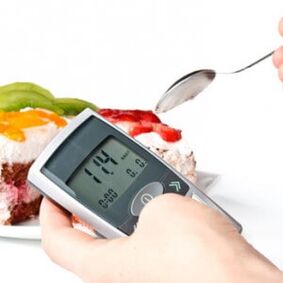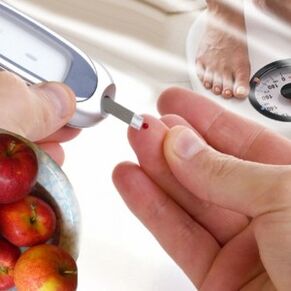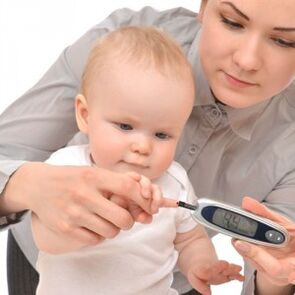
Diet diabetes mellitus is one of the methods of disease control to prevent the development of acute and chronic complications. The main task of therapeutic measures is to normalize metabolic processes in the body by optimizing blood sugar levels to the maximum allowable value.
The key to a patient's well-being is adhering to a diet with a limited amount of carbohydrates and well-chosen drug therapy.
If you do not start treatment of the disease in a timely manner, diabetes mellitus complicates the kidneys, nervous system, blood vessels, eyes, heart.
Etiology and pathogenesis
Today, 4% of the world's population suffers from this disease. According to the WHO, 8640 people with diabetes die every day worldwide, 3 million people die every year. This figure is several times higher than the death toll from hepatitis and AIDS. According to data from the International Diabetes Federation, in 2014, the total number of carriers of the disease was 285 million. At the same time, according to forecasts, by 2030. their number could increase to 438 million.
Etiology of the disease:
- obesity;
- hereditary tendencies;
- viral infections (flu, tonsillitis), resulting in damaged islet apparatus and latent diabetes forming;
- mental / physical trauma;
- vascular disorders, autoimmune.
External factors contributing to the development of diabetes mellitus:
- mental stress, stress, fear, prolonged fear;
- eat foods with excessive amounts of carbohydrates, saturated sugars;
- prolonged overeating.
Symptoms of diabetes in men and women:
- weakness;
- polyuria (increased urine volume up to 8 l / day);
- weight loss;
- hair loss;
- sleepy;
- increased urination;
- strong thirst;
- decreased libido, potency;
- itchy feet, palms, perineum;
- increased appetite;
- wounds do not heal well;
- decreased visual acuity;
- The smell of acetone from the mouth.
If you notice any signs of illness, you should immediately see a doctor, as the effectiveness of diabetes treatment directly depends on the rate at which the first symptoms of the disease are detected, the conclusion of diagnosis and the implementation of drug therapy. Remember, in the early stages, the disease is easier to treat.
Classification of Diseases and Role of Nutrition

The main role after drug therapy should be given to the patient's diet.
The type of diet depends on the degree of pancreatic depression, its mechanism of manifestation and method of treatment.
Level of disease
- Type 1 diabetes. It is a severe autoimmune disease associated with impaired glucose metabolism. In this case, the pancreas does not produce or produce too little insulin needed to maintain vital bodily functions.
- Type 2 diabetes. Often this form of the disease develops in people who are inactive with age, who are overweight more than 15% of their total weight.
- Diabetes pregnancy. This type of diabetes mellitus develops in 4% of women during pregnancy, more often in the second trimester. Unlike the first two types of disease, in most cases it disappears immediately after the birth of a child, but sometimes it can turn into second type diabetes. . . .
The less common forms of diabetes mellitus that occur in 1% of the world's population are prediabetes, latent, neurogenic, kidney, steroid, bronze, MODY.
Types of Diabetes Diet
Insulin injections, hypoglycemic drugs and physical activity are important in achieving positive dynamics in the treatment of this disease. However, according to some doctors (A. Bronshtein, E. Malysheva, V. Kononov), proper diet plays a fundamental role.
Type of nutrition program

- Carbohydrate-free diet is a technique based on the intake of complex carbohydrates from vegetables, fruits - in large quantities, and the exclusion of foods containing moderate carbohydrates from the menu.
- Protein diet for diabetes. This diet is based on the principle of minimizing carbohydrate and fat intake by increasing protein in food. The main emphasis in the methodology is the replacement of meat with lean fish, poultry and fermented dairy products.
- Low carb diet, used to compile menus for type 1 diabetes patients. 2.
- Diet soba. Regular consumption of this product has a beneficial effect on the body: lowers "bad" cholesterol levels and eliminates it with iron, rutin, calcium, magnesium, fiber, iodine, vitamin B. A buckwheat diet for diabetes helps reduce the possibility of macrovascular complications and boils.
- Diabetes prevention diet is designed to reduce the risk of developing pancreatic dysfunction.
With the onset of exacerbations of the cardiovascular system, diet 10 is practiced for diabetes mellitus. Its uniqueness is to reduce the consumption of fluids, salts, fats, carbohydrates, as these substances burden the liver, kidneys, and stimulate the nervous system.
Let's take a closer look at what type of diet is needed for diabetes mellitus, recipes for dishes that are allowed to be eaten during the diet.
Carbohydrate Calculation

When detecting diabetes mellitus, it is important to balance the intake of carbohydrates and glucose-lowering substances in the body properly. To calculate the caloric content of the product, a universal parameter called bread unit is used. At the same time, 1 XE (10 - 13 g of pure carbohydrate) increases glucose to 2, 77 mmol / l and "requires" 1, 4 units of insulin for its absorption. Since injections are given before the start of a meal, it is important to plan a one-time ration in advance.
The carbohydrate content in a meal must be 4-6 units of bread. The frequency and timing of meals directly depends on the type of sugar-reducing medication.
Number of products matching 1XE:
- sugar - 1 tbsp. ;
- honey - 1 tbsp. l. ;
- spaghetti - 1. 5 tablespoons. ;
- fruit juice - 150 ml;
- ice cream - 60 g;
- sweet water with gas - 180 ml;
- bread (rye, white, black) - 25 g;
- pancakes or pancakes - 1 pc. ;
- doh - 25 g;
- watermelon - 300 g;
- porridge (oats, buckwheat, wheat) - 2 tbsp. l. grain;
- sausage - 200 g;
- kefir, fermented baked milk, milk - 250 ml;
- mashed potatoes - 100 g;
- apple - 100 g;
- beans (peas, beans) - 5 tbsp. l. ;
- kiwi - 150 g;
- pir - 90 g;
- orange - 100 g;
- beri - 150 g;
- plum - 100 g;
- pic - 150 g;
- watermelon - 400 g;
- dried fruit (prunes, raisins, dried apricots) - 20 g.
Carbohydrate saturation from the daily diet of diabetics should not exceed 17 units of bread (2000 kcal).
In addition to calculating saccharides, it is important for patients with pancreatic dysfunction to choose foods to eat carefully based on prohibited and permitted ingredients.
| Product Category | Allowed | Available in limited quantities |
Foods Prohibited |
|---|---|---|---|
| Bread products | Separate | Wheat, whole grains, black wheat, second grade flour | Puff pastry, pastry |
| Meat and Poultry | - | Varieties of beef, lamb, chicken, turkey, rabbit, boiled tongue, diet sausage | Fatty pork, beef, geese, duck, canned food, sausages, smoked meats, smoked sausages |
| First course | Borscht, cabbage soup, fish soup, soup: mushrooms, fish, beets | Low fat Solyanka | Noodle soup, fatty broth, traditional kharcho |
| Fish | Slim Fish Fillet | Shellfish, squid, shrimp, oysters, coral, fish from the salmon family (trout, salmon, salmon) | Eels, caviar, canned food in oil, fish from the herring family (sprat, sprat, herring), sturgeon (stellate sturgeon, beluga, sturgeon) |
| Dairy products, milk fermentation | Milk, kefir, cheese without salt 25-30% | Homemade yogurt, 0% milk, feta cheese, 5% cottage cheese, curdled milk, fermented baked milk | Sour cream, 50-60% cheese, salted cheese, glass curd, butter, condensed milk, cream |
| Porridge | Soba, pearl barley, oatmeal, barley, millet | - | Semolina, brown rice, pasta |
| Vegetables | Carrots, cabbage (all kinds), beets, pumpkins, tomatoes, zucchini, eggplant, onions, radish, radish, mushrooms, cucumbers, fresh greens, peppers | Corn, boiled potatoes, fresh beans | Fries, sauteed vegetables, pickled and salted vegetables |
| Fruit, give | Quince, lemon, cranberry, pear | Plum, apple, peach, orange, cherry, blueberry, watermelon, raspberry | Grapes, figs, dates, raisins, bananas |
| Dessert | Fruit Salad | Sambuca, compote, sweetened mousse, fruit jelly, green cocktail with honey (1 dec. l. ) | Ice cream, cakes, fatty biscuits, cakes, jams, puddings, candies, milk chocolate with nuts |
| Sauces and spices | Mustard, pepper, carrot, tomato juice, cinnamon, dried spices and herbs | Homemade mayonnaise | Ketchup, sauteed vegetables, purchased sauces |
| Drinks | Tea, cocoa, coffee powder (without sugar and cream), raspberry stew and stew, unsweetened fruit nectar, sour berry drink | Natural vegetable juice (diluted) | Lemon sugar, kvass, sugary drinks, alcohol |
| Fat | - | Vegetable oils (flaxseed, corn, olive sunflower), unsalted butter | Lard, meat fat |
After converting carbohydrates into bread units, it is important to determine the amount of insulin needed to use blood sugar after birth. Following these recommendations will help prevent life-threatening conditions - hyper and hypoglycemia.
Diet for class 1 diabetes

Diet type 1 diabetes is based on strict control of blood glucose concentrations at levels (3, 5… 5. 5 mmol / l).
Consider the food intake feature, which allows you to keep its levels within set limits.
- The maximum daily caloric content of a meal (daily amount) is 2000 kcal.
- Fractional nutrition (at least 5 times).
- Remove pure sucrose from the menu to lower blood glucose.
- Spread the main dose of carbohydrates for breakfast and lunch.
- Do not eat at night.
- Avoid intake of easily digestible carbohydrates: baked goods, honey, jams, preservatives.
- Use natural sweeteners as sweeteners.
- To monitor the quality, "beauty" of the product.
- Adjust the insulin therapy schedule for meals (long-acting medications are given before meals, short - after meals).
- Calculate the number of units of bread to take into account the amount of carbohydrates consumed per day. For one meal, you can not eat more than 8 XE.
If there is gastrointestinal disease (pancreatitis, boils, gastritis), the diabetes mellitus diet prohibits the consumption of products such as: pickles, smoked meats, rich broths, coffee, carbonated beverages, alcohol, mushrooms, canned foods that stimulate excessive enzyme production, becauseaffects the rate and level of carbohydrate absorption.
Type 1 Diabetes Foods Allowed:
- unleavened fuel (lavash);
- berries, fruits (plums, cherries, lemons, apples, pears, oranges);
- soy products (tofu, milk);
- cereals (pearl barley, oatmeal, buckwheat porridge);
- vegetarian puree soup;
- drinks (slightly carbonated mineral water, berry mousses, dried fruit compote);
- vegetables (onions, zucchini, peppers, beets, carrots);
- beans (not baked);
- weak coffee, green / black tea / sugar-free fruit.
Do not eat:
- soup, rich gravy;
- pasta, flour products;
- sweets (cakes, pastries, sweets, chocolate, muffins);
- fast food, semi-finished products;
- alcoholic beverages (it is strictly forbidden to consume red dessert wine);
- sour, smoked, spicy foods;
- fatty meats (pork, lamb, duck), fish (mackerel).
The daily caloric intake of obese patients in this diet with insulin is in the range of 1200-1400 kcal. If there is no need to get rid of extra pounds, the portion of the dish can be increased.
A week-long diet for overweight insulin addicts
Day # 1
- breakfast - bread - 1 piece, porridge - 170 g, green tea, cheese - 40 g;
- second breakfast - pear - 0, 5 pcs, light cheese - 60 g;
- lunch - borscht - 250 g, boiled cabbage - 200 g, vegetable salad - 100 g, steamed pieces - 100 g, lavash;
- afternoon tea - rosehip broth, cottage cheese - 100 g, fruit jelly - 100 g;
- dinner - zrazy cauliflower - 100 g, vegetable salad - 150 g;
- before bed - milk - 200 ml.
Day # 2
- breakfast - boiled beef - 50 g, green tea, omelet, tomatoes - 1 pc, bread - 1 piece;
- second breakfast - grapefruit or orange - 1 pc, pistachios - 50 g;
- lunch - chicken breast - 100 g, vegetable salad - 150 g, pumpkin porridge - 150 g;
- afternoon tea - grapefruit - 1 pc. , kefir - 200 ml. ;
- dinner - boiled fish - 100 g, boiled cabbage - 200 g;
- Bedtime - Sugar-free cracker - 50g
Day # 3
- breakfast - lavash, weak coffee without sugar, cabbage rolls with meat - 200 g;
- second breakfast - strawberries - 120 g, yogurt - 200 ml;
- lunch - pasta - 100 g, vegetable salad - 100 g, steamed fish - 100 g;
- afternoon tea - orange - 1 pc, dried fruit stew;
- dinner - cottage cheese casserole with pears - 250 g;
- before bed - kefir.
Day 4
- breakfast - porridge - 200 g, green tea, cheese - 70 g boiled eggs - 1 piece. ;
- second breakfast - toast with cheese, turkey;
- lunch - boiled zucchini with meat - 200 g, vegetarian puree soup - 150 g, bread - 2 seeds. ;
- afternoon tea - lean cookies - 15 g, unsweetened black tea;
- dinner - green beans - 200 g, boiled chicken - 150 g, rosehip broth;
- before bed - dry diet bread - 3 seeds.
Day # 5
- breakfast - low-fat cottage cheese (up to 5%) - 150 g, kefir - 200 ml;
- second breakfast - pumpkin seeds - 2 tbsp, raisins - 3 tbsp;
- lunch - baked potatoes - 100 g, vegetable salad - 150 g, sugar-free compote - 100 g;
- afternoon snack - unsweetened fruit tea, grilled pumpkin - 150 g;
- dinner - vegetable salad - 200 g, steamed slices - 100 g or pancakes with blueberries on rye flour - 250 g;
- before bed - kefir 1%.
Day 6
- breakfast - boiled eggs - 1 pc, fruit tea, lightly salted salmon - 30 g;
- second breakfast - cottage cheese - 150 g, carrots - 1 pc. ;
- lunch - green borscht - 250 g, cabbage rolls with brown rice and carrots - 170 g; pita;
- afternoon snack - kefir - 150 ml. , bread - 2 seeds;
- dinner - fresh peas - 100 g, boiled chicken - 100 g, boiled eggplant - 150 g;
- before bed - dry crackers - 50 g.
Day 7
- breakfast - ham - 50 g, buckwheat porridge - 200 g, green tea;
- Second breakfast - tuna salad, cucumber, cherry tomato, whole wheat bread - 150 g;
- lunch - boiled zucchini with carrots - 100 g, cabbage soup - 250 g, bread - 1 piece, chicken pieces - 50 g;
- afternoon tea - cottage cheese - 100 g, apricot or plum - 4 seeds;
- dinner - schnitzel squid with onions - 150 g, dried fruit compote;
- before bed - milk - 200 ml.
A low-carbohydrate diet for diabetes is a strict balanced diet for patients to maintain sugar within normal range and systematic weight loss.
Type 2 Diabetes Diet

Basics of Dietary Health Nutrition:
- replace refined carbohydrates with sweeteners;
- BZHU ratio should be 20%: 30%: 50%;
- reduces animal fat intake by up to 50%;
The caloric content of the daily diet depends on the patient's energy consumption and weight.
Diabetes Diet 9 or Table 9 is a balanced program for diabetics with mild to moderate obesity. Adhering, the patient's diet consists of: protein (100 g. ), Carbohydrates (320 g. ), Fat (80 g. ), Of which 30% are unsaturated triglycerides.
A type 2 diabetes diet is very similar to a nutrition program for people who monitor their health:
- divide the total daily diet into 5 meals: 2 snacks at 1-2XE, 3 main meals at 5-8XE;
- do not miss breakfast;
- maximum rest between meals - 4 hours;
- last meal in the afternoon - 1. 5 hours before bed;
- between meals, it is recommended to eat vegetable salads, fruits, fresh juices, dried fruit broth, kefir, milk, green tea or fruit, unsweetened biscuits (crackers), bread.
Daily diet for type 2 diabetes
Day # 1
- breakfast - asparagus - 100 g. scrambled eggs from 3-4 quail eggs;
- second breakfast - walnut salad, squid, apple - 200 g;
- lunch - baked eggplant filled with pomegranate, beans - 100 g, beets - 250 g;
- afternoon tea - avocado ice cream and cocoa - 100 g;
- Dinner - salmon steak with carrot sauce - 200 g
Day # 2
- breakfast - yogurt, whole wheat rolls - 200 g (you can use stevia or agave nectar as a sweetener), apples - 1 piece.
- second breakfast - fruit smoothie (grind in a blender 80 g per cherry, strawberry, watermelon and 4 ice cubes);
- lunch - roast beef - 150 g, vegetable stew - 200 g;
- afternoon snack - cottage cheese and pear casserole - 150 g;
- dinner - vegetable mixture - 200 g, avocado - half of the fruit.
Day # 3
- breakfast - fried eggs from two eggs with the addition of low-fat cheese, basil, tomatoes;
- second breakfast - "steam" vegetables - 100 g, hummus - 100 g;
- lunch - vegetarian puree soup - 200 g, green beans - 50 g pieces of chicken - 150 g;
- afternoon tea - pear - 1 pc. , almonds - 50 g;
- Dinner - salmon - 150 g, yogurt, spinach.
Day 4
- breakfast - roasted fruit (apples, plums, cherries) in agave nectar - 200 g;
- second breakfast - sandwich with tuna and lettuce;
- lunch - beef - 150 g, boiled cauliflower - 200 g, tomato salad, arugula, parmesan - 100 g;
- afternoon snack - fruit and berry dessert (cut mango, kiwi, strawberry, combine with snow, pour orange and frozen juice) - 150 g;
- dinner - broccoli rolls - 200 g.
Day # 5
- breakfast - orange - 1 pc. ; fruit tea, low-fat cheese - 30 g, bread - 2 seeds. ;
- second breakfast - beet salad with beans - 200 g;
- lunch - rice - 200 g, salmon, steamed - 150 g, grapefruit - 1 piece. ;
- afternoon tea - berries with whipped cream 10% - 150 g;
- dinner - rosehip broth, squid schnitzel with onions - 200 g.
Day 6
- breakfast - carrot soufflé and cottage cheese - 200 g;
- second breakfast - zrazy cauliflower - 100 g;
- lunch - tangerine salad, chicken breast, arugula - 200 g, dried fruit compote, vegetable borscht - 200 ml;
- afternoon tea - kiwi, raspberry mousse - 200 ml. ;
- dinner - steamed cod with carrots - 200 g, kefir.
Day 7
- breakfast - baked apples stuffed with oat flakes, nuts, raisins - 1 pc. ;
- second breakfast - fruit and vegetable salad kohlrabi, celery, pears - 200 g, shrimp - 100 g;
- lunch - polenta - 200 g, green, boiled stew - 200 g, kiwi - 1 piece. ;
- afternoon tea - strawberries with mascarpone - 100 g;
- dinner - cucumber salad with onions, spinach - 250 g, green tea.
Depending on the course of the disease, changes can be made in the patient menu.
Remember, the above diet is not a universal nutritional system for all diabetics, so it is important to monitor your well-being while following it. If declining, "problematic" foods should be excluded from the menu.
Diet Diabetes Gestational

In some cases, the pancreas does not function in the body of the pregnant mother, and as a result, pregnancy diabetes develops. In most cases, this condition is easily controlled with proper nutrition.
Diabetes diet during pregnancy
- Eliminate sugars, sweets, toast, semolina, sweet fruits, foods that contain sweeteners from the diet.
- Balance the daily menu. Daily carbohydrate intake is 50%, protein - 30%, fat - 15-20%. At the same time, Malysheva diet for diabetes provides to minimize the amount of food intake, which contains plant and animal triglycerides (5-10%).
- Observe the drinking regime - 1. 5-2 liters of water a day.
- Like daily meals with starches (cereals, rye bread, brown rice, beans, sweet potatoes, Jerusalem artichokes, carrots, beets) and fermented dairy products.
- Snacks on fresh fruit.
- Spread the daily food intake into 3 main meals (breakfast, lunch, dinner) and 2 snacks (lunch, afternoon snacks).
- Enrich your daily diet with multivitamin complexes for pregnant women.
- Reduce sugar with traditional medicine using decoctions of celery root, linden flowers, blueberry leaves, purple buds, peas.
- Limit caffeine intake. The amount of alkaloids allowed is 2 servings of coffee or tea.
The optimal calorie intake of a pregnant woman's daily diet is 2000 - 2500 kcal. At the same time, a carbohydrate-free diet for pregnancy diabetes is prohibited.
Recommended menu for pregnant mothers with high blood glucose
- breakfast - millet porridge - 150 g, fruit tea, rye bread - 20 g;
- second breakfast - dry whole wheat bread - 50 g, 17% unsalted cheese - 20 g, apples - 1 pc. ;
- lunch - buckwheat porridge - 100 g, cabbage mixture, Jerusalem artichoke, cucumber - 150 g, beef stew - 70 g;
- afternoon tea - 5% cottage cheese - 100 g, sugar-free crackers - 2 pieces. , orange - 1 piece. ;
- dinner - boiled chicken fillet - 60 g, garnish vegetables (carrots, cabbage, peppers) - 100 g, tomato juice - 180 ml, bread - 2 seeds. ;
- 3 hours before bed - kefir / yogurt - 200 ml.
In addition to following a special diet, gestational diabetics are shown walking (40 minutes a day) and moderate physical activity (gymnastics, water exercise).
Diet for insulin-dependent diabetes in children

Diabetes mellitus in childhood and adolescence is much more difficult to carry than in adults. Children's genetic predisposition, stress and poor nutrition are the main causes of the development of autoimmune diseases.
In 80% of cases, children are diagnosed with insulin-dependent diabetes (type 1). Early diagnosis, immediate treatment and adherence to a specific diet will help prevent the consequences of the disease.
Diabetes diet in children
- Exclude from the menu sugar, soda, sweets, whole wheat bread products, fried foods, baked goods.
- Rich in your daily menu with sugar-free fruits, vegetables and herbs (unlimited). Prohibited - grapes, bananas, raisins, dates, persimmon, figs.
- Use natural sugar substitutes.
- Divide your daily food intake into 6 meals. At the same time, it is important to eat food regularly. The allowable deviation in the child's feeding schedule is 15-20 minutes.
- Food should be taken after 15 minutes. after the introduction of insulin and 2 hours after injection.
- If you can not eat at the appointed time, you can eat bread, pears, beans, cheese sandwiches or apples as a snack. In any case you must be hungry
- Taking some chocolate immediately will help stop hypoglycemic attacks. Therefore, adults accompanying children should always provide sweet products.
- Enrich your child's daily diet with fermented dairy products.
- Calculate your daily fructose intake. The amount of sugar substitute directly depends on the age of the child and the type of course of the disease.
To lower blood glucose, it is recommended for children to give a decoction of blueberries, nettles, corn stalks, mint leaves, barberry branches, peas, Jerusalem artichokes, ginseng and eleutherococcus.
Thus, diet for diabetics plays an important role, as the well-being and life of the patient depends on the truth of its composition. Therefore, it is very important to consider very carefully and carefully in the preparation of the diet and its adherence, otherwise negligence can lead to tragic consequences.




























